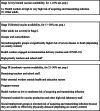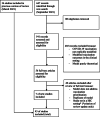Models of COVID-19 vaccine prioritisation: a systematic literature search and narrative review
- PMID: 34847950
- PMCID: PMC8632563
- DOI: 10.1186/s12916-021-02190-3
Models of COVID-19 vaccine prioritisation: a systematic literature search and narrative review
Abstract
Background: How best to prioritise COVID-19 vaccination within and between countries has been a public health and an ethical challenge for decision-makers globally. We reviewed epidemiological and economic modelling evidence on population priority groups to minimise COVID-19 mortality, transmission, and morbidity outcomes.
Methods: We searched the National Institute of Health iSearch COVID-19 Portfolio (a database of peer-reviewed and pre-print articles), Econlit, the Centre for Economic Policy Research, and the National Bureau of Economic Research for mathematical modelling studies evaluating the impact of prioritising COVID-19 vaccination to population target groups. The first search was conducted on March 3, 2021, and an updated search on the LMIC literature was conducted from March 3, 2021, to September 24, 2021. We narratively synthesised the main study conclusions on prioritisation and the conditions under which the conclusions changed.
Results: The initial search identified 1820 studies and 36 studies met the inclusion criteria. The updated search on LMIC literature identified 7 more studies. 43 studies in total were narratively synthesised. 74% of studies described outcomes in high-income countries (single and multi-country). We found that for countries seeking to minimise deaths, prioritising vaccination of senior adults was the optimal strategy and for countries seeking to minimise cases the young were prioritised. There were several exceptions to the main conclusion, notably that reductions in deaths could be increased if groups at high risk of both transmission and death could be further identified. Findings were also sensitive to the level of vaccine coverage.
Conclusion: The evidence supports WHO SAGE recommendations on COVID-19 vaccine prioritisation. There is, however, an evidence gap on optimal prioritisation for low- and middle-income countries, studies that included an economic evaluation, and studies that explore prioritisation strategies if the aim is to reduce overall health burden including morbidity.
Keywords: COVID-19, Vaccination, Mathematical modelling.
© 2021. The Author(s).
Conflict of interest statement
The authors declare that they have no competing interests.
Figures


References
-
- WHO Coronavirus (COVID-19) Dashboard. https://covid19.who.int/. Accessed 20 Sept 2021.
-
- World Health Organization. WHO SAGE values framework for the allocation and prioritization of COVID-19 vaccination. https://www.who.int/publications/i/item/whosage- values-framework-for-th.... Accessed 8 June 2021.
-
- World Health Organization. WHO Strategic Advisory Group of Experts (SAGE) on Immunization Working Group on COVID-19 Vaccines: Prioritized Infectious Disease and Economic Modelling Questions. https://www.who.int/immunization/policy/sage/SAGE_WG_COVID19_Vaccines_Mo.... Accessed 8 June 2021.
-
- Popay J, Roberts H, Sowden A, Pettricrew M, Arai L, Rodgers M et al. Guidance on the Conduct of Narrative Synthesis in Systematic Reviews. https://www.lancaster.ac.uk/media/lancaster-university/contentassets/ do.... Accessed 8 June 2021.
Publication types
MeSH terms
Substances
Grants and funding
LinkOut - more resources
Full Text Sources
Medical
Miscellaneous

